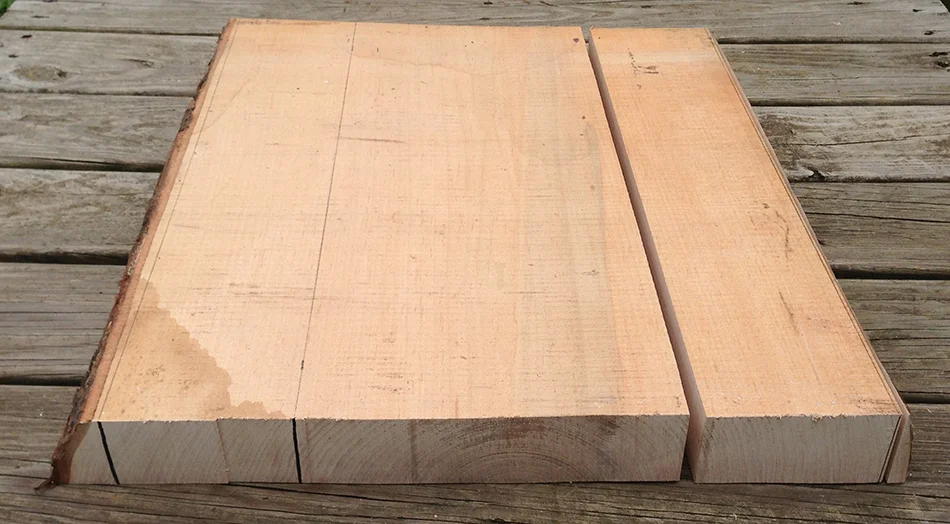Updated April 5, 2020
After milling the blanks for the rear legs I turn my attention to the slat blanks. For the best joint I use wood with quarter sawn end grain. When assembled, the radial plane in the slat tenon will run parallel to the long grain in the leg which makes the mating parts of the joint as compatible as possible. The quarter sawn board pictured at the beginning of the last post has more than 5″ of clear, quarter sawn end grain on both sides of the board. I have cross cut the piece pictured below to about 22″ in length from that longer board. I generally look for a blank that is clear and free from defects. This board has no defects and straight long grain so it’s perfect for slats. It’s possible to use wood with very small defects or very small knots, but occasionally while bending the slat will kink at the point of even a small knot.
To layout, I draw a reference line parallel to the bark edge and then a second line about 5″ away and parallel to it. I freehand cut both layout lines on the bandsaw as shown with the blank on the right. With careful milling this blank will yield up to 6 slats, enough for two side chairs or one rocker. Because I am building one chair I won’t cut out the second slat blank at this time. The rift sawn wood remaining in the center is perfect for front legs and rungs.
Once I have cut out blanks for the parts that require specific end grain orientation—rift sawn end grain for rear legs and quarter sawn end grain for slats—I am ready to mill blanks for the front legs and rungs from the wood that remains. Pictured below is the 2ʹ long butt end section of the rift sawn board that I used for the rear legs. This piece has quite a bit of flair toward the butt end so I am very careful to layout the parts as parallel to the long grain and the bark edge as I can. I am aiming for straight long grain with as little run-out as possible. Front legs can have small defects. I am not concerned with the end grain orientation because these parts are straight and cylindrical so they can be rotated to the correct grain orientation at the time of rung mortising (front legs) or assembly (rungs). This piece will yield 4 front legs and 4 pairs of rungs.
Here is the same board cut into parts. I actually got an extra pair of rungs so the total from this piece is 4 front legs and 10 rungs. The only reason the wedge shaped section in the center is waste is because of the staining. Otherwise I could have gotten another front leg or some more rungs.
And finally a photo of all the parts for this chair: 2 rear legs with rift sawn end grain, 2 front legs, a slat blank with quarter sawn end grain, 7 lower rungs in soft maple (including 1 extra) and 5 seat rungs in hickory (including 1 extra). In the finished chair the seat rungs must hold up to the enormous strain of the seating material wrapped around them and the weight of someone sitting in the chair. If the primary wood is relatively soft I used a harder wood such as hickory, white oak, ash, or hard maple for the seat rungs. Species that are not strong enough to be used as seat rungs include soft maple, cherry and walnut.
In the next post I will demonstrate how to mill a rear leg blank for steam bending.
Side Chair Build Series Links:
Next Post: Preparing the Rear Legs for Bending
Previous Post: Milling Blank Parts, Part 1 — Rear Legs



